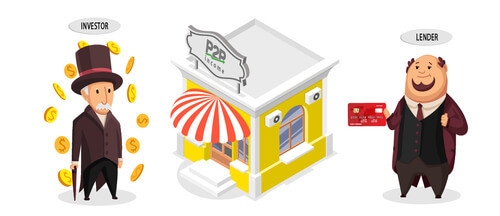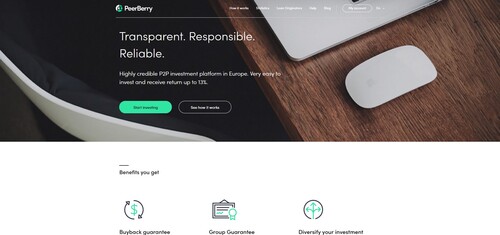P2P Lending | Does Market Size Matter?
As financial innovations continue to develop and become more efficient, peer-to-peer lending, and it's technological offspring will become more prevalent. The sharing economy of finance will define and eventually mint a new breed of investors who are solely or predominantly invested in to peer-to-peer lending services. This booming interest can only also be explained in numbers.
- In 2013, the p2p global market size for all peer-to-peer lending platforms stood at $3.5 billion.
- In 2019, the global market size for all peer-to-peer lending platforms stood at $67.93 billion.
- In 2027, if it continues on its trend it is expected to grow to $558.91 billion.
This guide will break down the largest market size platforms in Europe.
Mintos
Market Size: 6,282,800m €
Mintos is the largest peer-to-peer lending platform in Europe. They were founded in 2014 in Riga Latvia, but it was only in 2017 that Mintos saw explosive growth that took them all the way to the top rank, in terms of investors, loan originators, investor portfolio average and net returns. Since their ascension to the top Mintos has encountered a brand new array of problems that they seem to be tackling rather well. Investing on Mintos requires a 10 EUR minimum and the average return for customers is 9% to 12% in yearly returns.

Mintos uses an array of instruments to keep their ecosystem active and healthy. Mintos hosts two markets, the primary and secondary, this is where many lenders go to buy and sell loans in order to make a profit. All loans on Mintos are accompanied with a buyback guarantee to ensure to their investors there is a line of defense in case a borrower defaults on his loan. Not only are there buyback guarantees, but every borrower is required to put up a car or property as collateral. This makes for a secure system to transact in. The minimum investment is 20 EUR and the average investor on Mintos yields about 10% in yearly returns.
Equity and Debt
There is an interesting debate on whether or not businesses should sell equity to begin operations or request loans. Let's briefly side track here to do a quick illustration for the sake of explaining the importance of debt v. equity.
Picture this, you start a business, a candy store, and you have opened your business with an investor and lender. The investor purchases a stake in your business, and gives you a 1000 US dollars for 10% of ownership. Which means he will own 10% of the value and proceedings of the company. On the other hand, the borrower gives you a loan of a 1000 USD with an interest of 10%. This means you will be liable to the lender and in one year you will have to pay him 1,100 USD.

Now, let's say you're somewhat of a business wiz, and in the first year you're able to turn your candy store in to a store that generates 20,000 USD a year. What becomes important is that the investor is entitled to a tenth of the net profit in the first year and every year to come, which is 2000 USD per year. Whereas, the lender will only take home 1100. The moral of the story here being, the investor here rakes in far more money which means you as the business owner lose a lot more money.
Like all things, there is a catch. If your candy store were to fail you would not be required to pay back your investors. You will, however, have to pay back your lender. It is illegal to not pay back those who lent you money. This is because there is an understanding that the investor is taking upon himself the risk of the business. This is why he is entitled to both the full risk of losing everything and full reward of becoming highly profitable. If you're still interested in reading more about business loans, check out our guide on understanding peer-to-peer lending business loans.
TLDR: borrowing money preserves more value than selling equity.
PeerBerry
Market Size: 485,920m €
PeerBerry is a loan originator aggregator, which means the platform hosts several loan originators. Retail investors can then participate in PeerBerry's marketplace to purchase pre-funded loans from different loan originators. All the details of the listed loan originators are made available by PeerBerry. PeerBerry is always finding new loan originators to partner up with and service on their marketplace. Minimum investments start at 10 EUR and yearly gains range from 9% - 12%.

PeerBerry has a completely different approach to risk mitigation. Due to their approach they have found themselves as one of the top performing European P2P lending platforms despite being as young as they are. Their method starts off simply, as the loans on PeerBerry are by-and-large covered by the loan originators. The investors only purchase a small percentage of the loan contract from the loan originator. The loan originators on PeerBerry are more liable for the losses of the loans of defaulted loans than the investor, which is great if you're a retail investor.
The loan originator makes the majority of the profit, because they are taking on the risk and servicing of any loan on their platform. Investors then only take a small part, as they make the same return PeerBerry would have made, but PeerBerry charges them a fee. In this model, PeerBerry maintains the relationship between investors and borrowers and is only allowing investors to reap the benefits the loan originators would have reaped otherwise, but for a small fee. This is important because it in large part explains why the ecosystem on PeerBerry is so healthy and stable.
The second part of their approach is to reinforce security for all their loan originators as well as investors. PeerBerry has two different buyback guarantees, the standard buyback guarantee and the group guarantee. The group guarantee means that if a buyback guarantee fails, then the partner loan originators step in to help service the loan. This multi-layered risk management strategy has only proven to be highly profitable and enjoyable for their PeerBerry's investors, as no investor has ever lost funds on PeerBerry.
EstateGuru
Market Size: 339,280m €
EstateGuru is considered the top performing real estate crowdfunding platform in Europe. Though they began in Eastern Europe in Estonia, EstateGuru loan contracts can be found all over Europe today. Investing with EstateGuru requires a 50 EUR minimum and the yearly returns range from 8% - 12% in yearly returns.

EstateGuru offers loans that span all over Europe. All loans are backed by 1st and 2nd rank mortgages but users can invest in a few different types of projects:
- Hotels
- Apartments
- Condominiums
- Houses
- Malls
- Offices
Different projects come with different expected yearly yields, level of risk and loan duration. One can expect that loan contracts that are generated from apartment renovations, rentals and offices will pay smaller amounts more frequently. Whereas, large scale projects such as malls, condominiums and hotels will pay larger sums in between longer periods of time. EstateGuru has a very easy-to-use interface as well as a good functioning auto-invest tool.
There is some cash drag on EstateGuru which is to be expected on any real estate crowdfunding platform. In order to use EstateGuru's auto-invest tool you must deposit at least 250 EUR.
Otherwise, EstateGuru has only been able to attain the status that it has because of both professionalism and competence. The platform despite managing countless real estate crowdfunding projects have never lost or misplaced their investors' capital. Even during defaults or problematic loans, EstateGuru has always stepped in to properly provide a fund recovery strategy and protect its investors from bad actors and actions.
Is Bigger Better?
Bigger isn't necessarily better, but it's a good sign that the market place is more active. The more funding a peer-to-peer lending platform has, the less likely you're going to experience serious cash drag, which can cause serious losses to your portfolio over time. That being said, sometimes having less loans or a limitation of loans is done because of the lack of reliable borrowers in the marketplace. Having a larger market with potentially less quality loans is not necessarily a good thing. In some cases, you might be looking to invest a great deal of money. In such a scenario, a platform with a large number of loans will be necessary. You can find out more in our guide about platforms that can accommodate a well-endowed wallet.
In the short term, the best performing peer-to-peer lending platforms are very often the smaller ones, that apply more attention to detail. Rather than, large established platforms that no longer have the man power to give that personal touch. None of the smaller companies show up on this list because of their market caps simply being to small.

Market Type
Consumer Loans
Average Returns
9 - 12%
Minimum Investment
EUR 10
Signup Bonus
1%
Registered users
500,000
Total funds invested
EUR 8.9 Billion
Default rate
16%
Regulating entity
Financial & Capital Market Comission (Latvia)
Buyback guarantee
Secondary market
Payment methods
PayPal, Bank Transfer, Credit Card, TransferWise
Withdrawal methods
Wire transfer, Credit Card
Mintos is P2P loan originator aggregator whom after years of slow growth exploded and became the number one P2P lending platform in Europe. Find out why in this review. Is Mintos an investment worth considering?

Market Type
Consumer Loans
Average Returns
9 - 12%
Minimum Investment
EUR 10
Signup Bonus
0.5%
Registered users
70,000
Total funds invested
EUR 1.8 Billion
Default rate
7%
Regulating entity
Self-Regulated/EU Compliant
Buyback guarantee
Secondary market
Payment methods
Bank Transfer, Bank Card, TransferWise
Withdrawal methods
Bank Transfer, Bank Card, TransferWise
PeerBerry is an excellent P2P platform to its 100 percent successful fund recovery track record. They offer slightly below market interest rates in exchange for a guarantee users will never lose their funds.

Market Type
Mortgage Loans
Average Returns
8 - 13%
Minimum Investment
EUR 50
Signup Bonus
0.5%
Registered users
150,000
Total funds invested
EUR 700 Million
Default rate
6%
Regulating entity
Bank of Lithuania
Buyback guarantee
Secondary market
Payment methods
Bank Transfer, SEPA, Credit Card, TransferWise
Withdrawal methods
Bank Transfer, SEPA, Credit Card, TransferWise
EstateGuru is a highly recognized and successful P2P Lending company. What makes EstateGuru as P2P Lender so profitable and secure? Explore the breakdown with P2PIncome's thorough analysis of EstateGuru's strengths and weaknesses.
Verdict
Out of the three platforms that we took a look at, only PeerBerry provides a personalized experience. But their market cap is far too small in comparison to that of Mintos'. To be fair, none of the other platforms here can be compared to Mintos, which has processed well over 6 billion euros in loans. There is always a large gap between the #1 platform and the #2 platform. Mintos generates, at the very least, 10 times the amount in EUR than any other platform listed here, despite all of them being recognized as top platforms.
Mintos also offers a far larger variety in terms of loan types, contracts and returns. Mintos has a much higher default rate than that of PeerBerry and EstateGuru . Though, considering the volume of its marketplace and the diversity in risk levels, it is only reasonable to assume that there would be a higher default rate.


